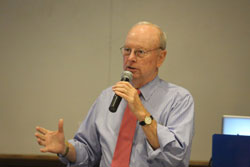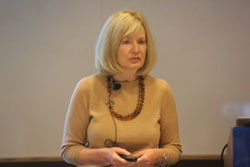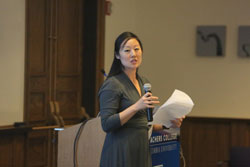Taking a Page From the World's Best Schools
A Teachers College initiative is sharing approaches and strategic practices from the world's top school systems
A Teachers College initiative is sharing approaches and strategic practices from the world’s top school systems
By Heather Smitelli and Joe Levine
With one of the world’s top-ranked school systems, why would Singapore’s education leaders look elsewhere for lessons on how to transform their schools for the 21st century?
“Because not only are they unembarrassed about learning from the rest of the world, they understand that strategic and effective practices can be found in every society,” says Deb Sawch (Ed.D.’13), Co-Director of Studies in Educational Innovation (SEI), a TC-based initiative that numbers Singapore’s National Institute of Education among its partners.
That same outlook drives SEI, which Sawch and her two co-directors, Alison Villaneuva (Ph.D. ’13) and Suzanne Choo (Ph.D. ’12) founded in 2010 to convene conversations about educational excellence in schools in the United States and around the world.
“It is so urgent to look at schools around the world and use our observations to inform our own work – not by replicating what other nations do, but by repurposing their ideas and practices to fit our own culture,” Sawch says. “SEI is bringing together the world’s most successful school districts to work together in what we think of as ‘coopetition,’ – everyone trying to get even better -- and our research has informed that work.”
Based within TC’s Center for the Professional Education of Teachers, which is directed by faculty member Ruth Vinz, SEI has joined with Scarsdale Public Schools, and Hwa Chong Institution in Singapore to launch the Global Learning Alliance (GLA), a consortium of school leaders from Shanghai, China; Helsinki, Finland; Toronto, Canada; Scarsdale, New York; Weston and Westport, Connecticut, Australia, and Singapore, with representatives from Teach for America. At working meetings held at TC and in Singapore, the Alliance is developing strategic approaches to improve teaching and learning in the schools of member districts using a Global Capacities Framework that resulted from the research that Sawch, Villaneuva and Choo conducted in the six countries of GLA.
(SEI will hold a summit conference of its Global Learning Alliance on April 8-10, 2014, at Teachers College.)
“How do we rethink how to educate our children, ourselves and others in this ever-expanding interconnected landscape in which we learn, live and are ultimately responsible?” Vinz, Enid and Lester Morse Professor in Teacher Education, asked leaders from more than 50 tri-state area schools who gathered at TC for an SEI conference in October. She answered her own question by quoting the former astronaut Michael Collins, who wrote that if the world’s political leaders could see their “midget earth” from space, “that all-important border would be invisible, that noisy argument suddenly silenced.”
“This is about entrepreneurship, rule-breaking – no one here can be accused of complacency,” Sawch said in her opening remarks.
The October event showcased specific work in Scarsdale, Westport, Weston and Finland that SEI believes can be useful to schools that may lack the abundant resources of these districts. Each presented ways in which they are working to provide meaningful learning environments in their schools.
In 2008, Scarsdale created an Innovation Center for its schools and enlisted teachers, parents and others to create “A Scarsdale Education for Tomorrow” – a curriculum that centers on learner independence, love of learning, critical thinking and non-standard problem-solving. The new curriculum replaces Advanced Placement exams, which have been criticized for covering too much ground in too short a period, with “Advanced Topic” courses that dive deep into subjects like the paintings of particular artists. Course content is enriched by “capstone” projects – independent research efforts that now stand as the culmination of many college courses – for all grade levels. And to achieve a deeper understanding of how each student is performing, Scarsdale now maintains electronic work portfolios for all middle schoolers.
Scarsdale’s transformation began with the recognition that a wholesale shift in its school culture was needed.
“In our district, we are highly risk-averse because our goal is to get kids into the finest colleges in the universe,” Michael McGill, Superintendent of Scarsdale Schools, told the conference participants. “We are willing to talk about change and innovation, but the minute any change or innovative idea begins to look like it might threaten the real mission of the organization—at the moment that starts to happen, we find lots of people in lots of different places saying ‘wait a minute, that’s an interesting idea, but maybe you ought to try that somewhere else.’”
Working in consultation with SEI, and through benchmarking of colleges and universities, Scarsdale has also created a “teacher innovation network” to share innovative practices and provide professional development; instituted game-based learning and service learning in middle school; incorporated an interdisciplinary wellness focus; instituted a number of courses and course features that promote global awareness; and engaged an outside architect to create “flexible learning” spaces that enable student collaboration and different teaching styles.
“What particularly resonated with our community and our faculty was the idea of non-standard, very challenging, complex problems,” said Lynne Shain, Assistant Superintendent for Scarsdale’s Curriculum and Instruction. “It was 2008, we were in a recession, and nobody seemed to be able to explain how we could get out of it. And just saying that seemed to rally various constituency groups”
Westport took a very different approach than Scarsdale, in 2010 creating a vision for “the Global Student of 2025” – but again the impetus was a desire to go beyond standard measures of success to create deeper learning. “If we looked at our student success rate, by every measure we were doing beautifully,” said Westport Schools Superintendent Elliott Landon. “College acceptances, SAT scores, our Connecticut Mastery Test scores – we were the best. But we felt we were lacking a vision for where we were going. We were doing the same old same old. And my fear was that in a globally competitive environment, our kids might very well be lacking the skills that we would hope they would have in order to be successful – skills that had to do with creativity, problem solving, communication skills, and global awareness,”
In 2006, a group of students at Westport’s Staples High School had won the $20,000 first prize in the first-ever Moody’s Math Challenge, an annual contest for high school students which that year challenged participants to solve the Social Security stalemate by developing one or more approaches to ensure the system’s solvency for at least 75 years.
In essence, the Westport reform effort of 2010 took a look back at that triumph and “we thought, ‘Why aren’t we doing this throughout the system?’” recalled Landon. “We wanted to get complete alignment with all of our stakeholders, so we not only reached out to all of our teachers and board members, but also had presentations with the community of Westport.”
Westport also engaged SEI to conduct a literature review and to provide a context by describing what the best school systems around the world were doing.
Ultimately, TC “helped us come to a common language,” Landon said.
The result, said Lisabeth Comm, Westport’s Director of Secondary Education, is a common language around a common framework” spoken by the entire district, and it has resulted in increased teacher effectiveness and student engagement.
On the front lines, the framework has given rise to changes such as a new first grade literacy unit, designed in conjunction with Teachers College, that includes student research, collaboration and problem-solving; a seventh grade cell biology and human body unit that includes a real-life disease outbreak investigation used by epidemiologists (with an accompanying simulated press conference); and a ninth grade social studies course that includes a case study of a region affected by Western imperialism, with a presentation to a live audience.
More broadly, the Westport approach – for students and teachers alike – emphasizes critical and creative thinking, risk-taking, embracing change, generating new possibilities, and asking questions that are analytical as well as fact-based. Teachers are provided with ongoing opportunities to conduct research of their own, often in conjunction with TC and other universities.
“The framework looks like a rubric [a set of specific expectations], but we’re not using as a rubric,” said Comm. “It is a planning tool for teachers. What that means is, depending upon the grade level you’re dealing with and the skills of the individual student, it might be perfectly appropriate for a group of kids to be at the far left [of the spectrum] – the simpler end – and not move to the far right.”
Simultaneously, Weston, CT District Public Schools reached out to SEI to design cornerstone assessments that could be used to inform 21st century teaching and learning. SEI worked closely with teams of teachers to adapt a framework for teaching and learning that would lead to the development of both formative and summative performance-based assessments that could be completed, measured and analyzed across grades and disciplines.
At the end of the day, Erick Gordon, co-founder with Vinz and former Director of TC’s Student Press Initiative, summarized the viewpoint underlying these approaches. “Nothing is a mistake – there’s no win, no fail,” he said. ”No one size fits all – multiplicity comes from a willingness to experiment and prototype. Doing is the new thinking.”
See video of the conference
Published Tuesday, Dec. 17, 2013



